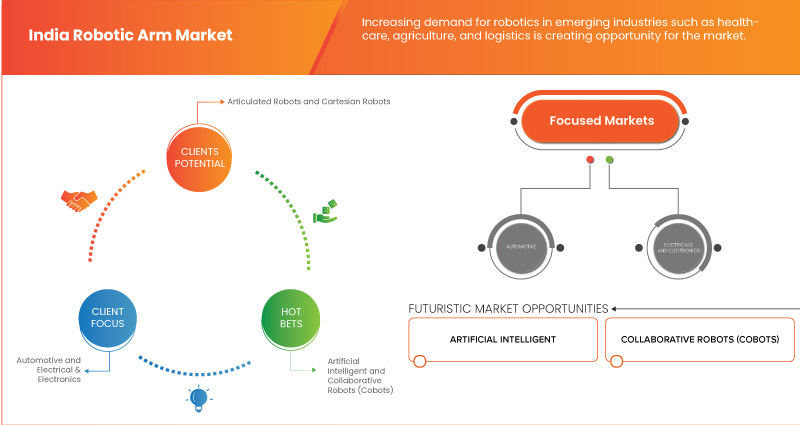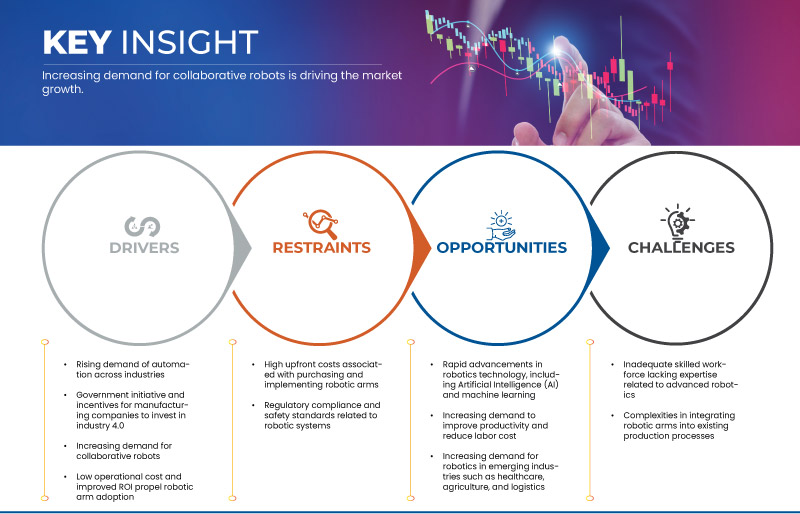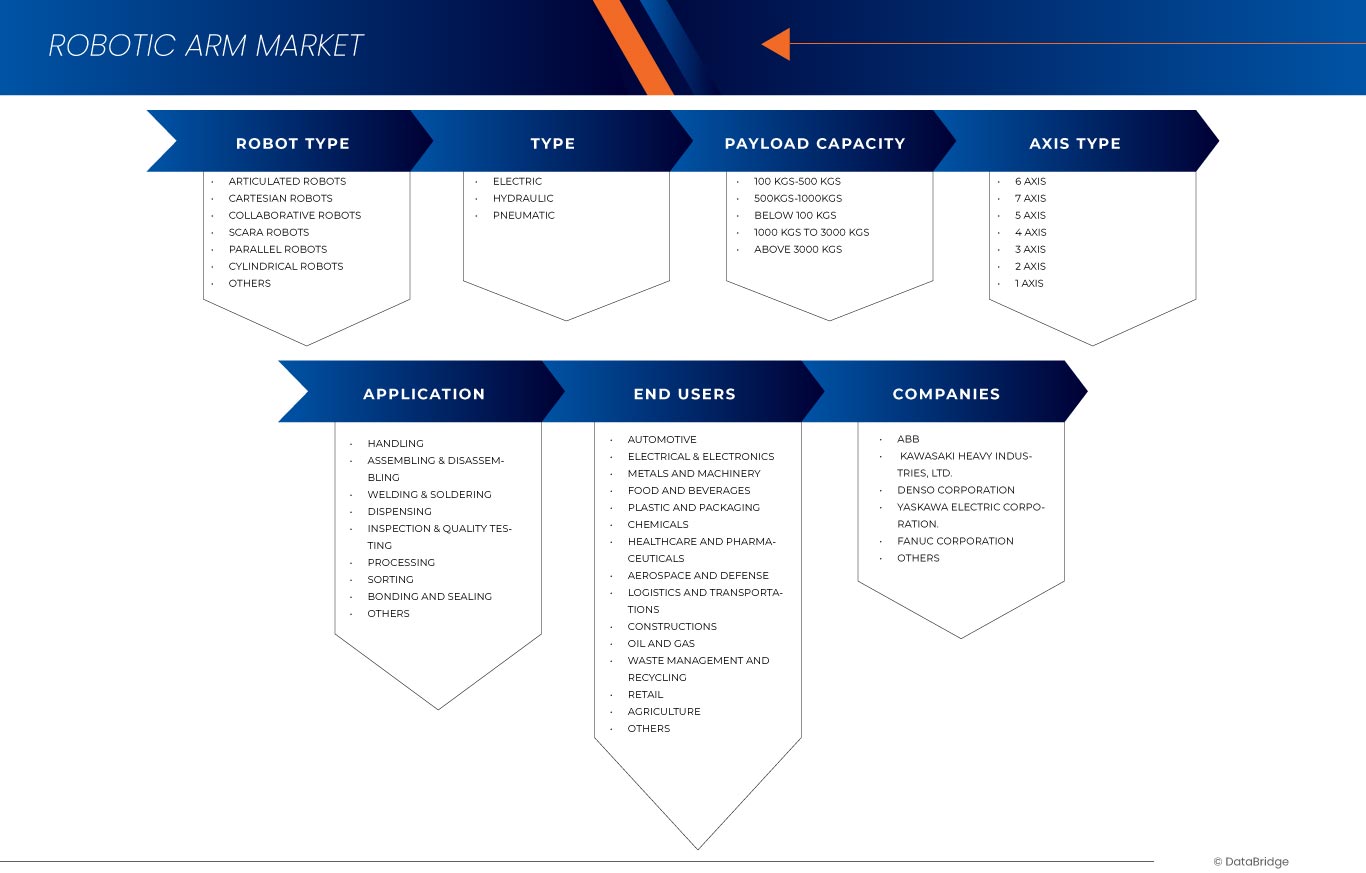India Robotic Arm Market
市场规模(十亿美元)
CAGR :
% 
| 2024 –2031 | |
| USD 12.29 Billion | |
|
|
|
|
印度机械臂市场,按机器人类型(关节机器人、笛卡尔机器人、协作机器人、SCARA 机器人、并联机器人、圆柱机器人等)、类型(电动、液压和气动)、有效负载能力(100 公斤 - 500 公斤、500 公斤 - 1000 公斤、100 公斤以下、1000 公斤至 3000 公斤和 3000 公斤以上)、轴类型(6 轴、7 轴、5 轴、4 轴、3 轴、2 轴和 1 轴)、应用(处理、组装和拆卸、焊接和焊接、分配、检查和质量测试、加工、分类、粘合和密封等)、最终用户(汽车、电气和电子、金属和机械、食品和饮料、塑料和包装、化学品、医疗保健和制药、航空航天和国防、物流和运输、建筑、石油和天然气、废物管理和回收、零售、农业等)——行业趋势和预测到 2031 年。
印度机械臂市场分析及规模
印度机械臂市场正在稳步增长,这得益于汽车、电子、医疗保健和制造业等各个行业的自动化程度不断提高。印度对机械臂的需求源于制造流程对精度、效率和成本效益的需求。此外,医疗保健等行业对机械臂的应用也在增加,例如手术辅助和康复,这进一步推动了市场增长。
Data Bridge Market Research 分析称,印度机械臂市场规模预计将从 2023 年的 47 亿美元增至 2031 年的 122.9 亿美元,在 2024 年至 2031 年的预测期内,复合年增长率为 13.1%。
|
报告指标 |
细节 |
|
预测期 |
2024 至 2031 年 |
|
基准年 |
2023 |
|
历史岁月 |
2022 (可定制为 2016-2021) |
|
定量单位 |
收入(十亿美元) |
|
涵盖的领域 |
机器人类型(关节机器人、笛卡尔机器人、协作机器人、SCARA 机器人、并联机器人、圆柱机器人等)、类型(电动、液压和气动)、有效负载能力(100 公斤 - 500 公斤、500 公斤 - 1000 公斤、100 公斤以下、1000 公斤至 3000 公斤和 3000 公斤以上)、轴类型(6 轴、7 轴、5 轴、4 轴、3 轴、2 轴和 1 轴)、应用(搬运、组装和拆卸、焊接和锡焊、分配、检查和质量测试、加工、分类、粘合和密封等)、最终用户(汽车、电气和电子、金属和机械、食品和饮料、塑料和包装、化学品、医疗保健和制药、航空航天和国防、物流和运输、建筑、石油和天然气、废物管理和回收、零售、农业等) |
|
覆盖国家 |
印度 |
|
涵盖的市场参与者 |
三菱电机公司、MCI Robotics、精工爱普生公司、Mecademic、川崎重工、Asimov Robotics、电装株式会社、Systematics、Svaya Robotics Pvt. Ltd、Gridbots Technologies Private Limited.、JanyuTech、ABB、发那科公司、Universal Robots A/S、安川电机公司、欧姆龙公司、库卡股份公司等。 |
市场定义
机械臂是一种可编程的机械装置,能够精确操纵物体。它通常由多个部分组成,称为连杆,这些部分通过关节连接。这些关节使手臂能够以与人类手臂相似的运动范围移动,使其能够执行各种任务。机械臂通常配备有末端执行器,例如夹持器或工具,使它们能够与周围环境互动。
印度机械臂市场动态
本节旨在了解市场驱动因素、优势、机遇、限制和挑战。下面将详细讨论所有这些内容:
驱动程序
- 各行业对自动化的需求不断增长
各行各业对自动化的需求不断增长,这是机械臂市场增长的主要驱动力。在制造业中,机械臂被广泛采用,以提高装配、焊接和物料搬运等任务的效率和精度。这些机器人使制造商能够通过提高生产能力来满足不断增长的消费者需求,同时确保产品质量始终如一。机械臂能够高精度地执行重复性任务,从而最大限度地减少人为错误并提高整体运营效率,使其成为当代制造环境中必不可少的。
- 政府为制造业企业投资工业 4.0 提供倡议和激励
印度政府正通过各种举措和激励措施积极推动采用工业 4.0 技术,包括机器人技术。一项值得注意的举措是生产挂钩激励 (PLI) 计划,该计划为投资于汽车、金属、制药和食品加工等行业生产能力的公司提供补贴,这些行业是机械臂的主要用户。该计划旨在提高这些行业的竞争力并吸引更多投资,从而推动市场对机械臂的需求。
此外,政府努力改善经商环境,为制造企业采用机器人等先进技术创造有利环境,这也是另一个重要推动因素。通过政策改革、基础设施建设和技能发展计划,政府正在为采用工业 4.0 技术培育支持性生态系统,预计这将进一步加速对机器人手臂的需求。
机会
- 机器人技术的快速发展,包括人工智能(AI)和机器学习
机器人技术,尤其是人工智能 (AI)和机器学习的快速发展彻底改变了各个行业。这些技术使机器人系统能够以前所未有的准确性和效率感知、学习和适应动态环境。人工智能机器人增强了决策能力,机器学习算法使机器人能够通过数据驱动的洞察力不断提高性能,从而提高生产力和运营效率。
- 提高生产力和降低劳动力成本的需求不断增加
提高生产力和降低劳动力成本的需求不断增长,促使各行各业迅速采用机器人技术。随着人工智能 (AI) 和机器学习的进步,企业寻求自动化解决方案来简化流程并提高效率。机器人技术可以优化生产工作流程、最大限度地减少错误并提高整体产量。这种转变不仅可以节省成本,还可以提高组织的生产力。因此,随着企业优先考虑运营效率和敏捷性,对机器人的需求持续激增。
限制/挑战
- 缺乏先进机器人相关专业知识的熟练劳动力不足
先进机器人和自动化技术在各个行业中的应用日益广泛,这就需要编程、操作和维护方面的专业知识,而这造成了巨大的技能差距。随着人工智能和深度学习等技术变得越来越复杂,对能够管理和优化这些系统的高技能专业人员的需求也在增长。然而,目前的劳动力往往缺乏使用这些复杂工具所需的培训和经验,导致行业需求与现有人才不匹配。要弥合这一技能差距,需要有针对性的教育计划、持续的专业发展以及行业和学术机构之间的合作努力,以使工人具备所需的能力。
- 将机械臂集成到现有生产流程的复杂性
将机械臂集成到现有生产流程中可能非常复杂且耗时。这些挑战通常源于需要将机器人系统与现有工作流程、设备和安全协议保持一致,同时确保与人类操作员的无缝沟通和协调。编程复杂性、设备兼容性和空间限制等因素进一步加剧了集成过程的复杂性。
最新动态
- 2024 年 5 月,ABB 推出 IRB 7710 和 IRB 7720,扩大了其模块化工业机器人手臂产品线,提供 16 种新型号,主要面向汽车 OEM 和一级供应商领域,以及物流、铸造、机械制造、建筑和农业应用。标准化模块化设计简化了安装,提高了灵活性和成本效益。这些机器人的路径精度低至 0.6 毫米,有效载荷高达 620 公斤,在高精度任务中表现出色,彰显了 ABB 对创新和客户满意度的承诺
- 2024 年 1 月,ABB 和 Simpliforge Creations 合作,为印度建筑行业提升 3D 打印能力。他们共同开发了南亚最大的机器人混凝土 3D 打印机,该打印机已用于创建印度首个 3D 打印礼拜场所和一座 3D 打印桥梁。此次合作旨在通过实现更快、更可持续、更安全的建筑方法来彻底改变建筑业
- 2023 年 9 月,安川电机株式会社在 2023 年 WeldfabMeet Pune 展会上表现出色,展示了尖端的焊接自动化解决方案,并强调了高质量焊接在工程和制造中的重要性。凭借其卓越的影响力和对创新的承诺,安川印度巩固了其在焊接自动化行业的领导地位,并准备继续为客户的自动化需求提供一流的解决方案
- 2022 年 2 月,安川电机在古尔冈马内萨尔开设了一家新的机器人解决方案工厂,旨在增强工业机器人自动化。该工厂展示了用于电弧焊、码垛和机器操作等各种应用的尖端技术,促进了与客户的更紧密合作。该工厂拥有占地 45,000 平方英尺的先进车间,支持定制机器人系统的制造、组装、测试和系统集成
- 2023 年 8 月,FANUC CORPORATION 印度公司在钦奈开设了新的技术中心。该设施加强了 FANUC CORPORATION 致力于以最先进的工厂自动化解决方案服务国家的承诺。该中心配备了必要的基础设施,旨在为钦奈快速发展的工业中心提供增强的服务,提供终身维护支持并促进技术进步。环保设计凸显了 FANUC CORPORATION 对可持续发展的奉献精神,同时满足了印度市场的需求并推动了印度制造计划
印度机械臂市场范围
印度机械臂市场分为六个显著的细分市场,根据机器人类型、类型、有效载荷能力、轴类型、应用和最终用户划分。这些细分市场之间的增长将帮助您分析行业中微弱的增长细分市场,并为用户提供有价值的市场概览和市场洞察,帮助他们做出战略决策,确定核心市场应用。
机器人类型
- 关节机器人
- 直角坐标机器人
- 协作机器人
- SCARA 机器人
- 并联机器人
- 圆柱形机器人
- 其他的
根据机器人类型,印度机械臂市场分为关节机器人、笛卡尔机器人、协作机器人、SCARA 机器人、并联机器人、圆柱形机器人等。
类型
- 电的
- 液压
- 气动
根据类型,印度机械臂市场分为电动、液压和气动。
有效载荷能力
- 100 公斤-500 公斤
- 500公斤-1000公斤
- 100公斤以下
- 1000 公斤至 3000 公斤
- 3000 公斤以上
根据有效载荷能力,印度机械臂市场分为 100 公斤 - 500 公斤、500 公斤 - 1000 公斤、1000 公斤 - 3000 公斤、100 公斤以下和 3000 公斤以上。
轴类型
- 6 轴
- 7 轴
- 5 轴
- 4 轴
- 3 轴
- 2 轴
- 1 轴
根据轴类型,印度机械臂市场分为 6 轴、7 轴、5 轴、4 轴、3 轴、2 轴和 1 轴。
应用
- 处理
- 组装和拆卸
- 焊接与锡焊
- 分配
- 检验与质量测试
- 加工
- 排序
- 粘接和密封
- 其他的
根据应用,印度机械臂市场细分为搬运、组装和拆卸、焊接和钎焊、分配、检查和质量测试、加工、分类、粘合和密封等。
最终用户
- 汽车
- 电气和电子产品
- 金属和机械
- 食品和饮料
- 塑料和包装
- 化学品
- 医疗保健和制药
- 航空航天和国防
- 物流与运输
- 建筑
- 石油和天然气
- 废物管理和回收
- 零售
- 农业
- 其他的
根据最终用户,印度机械臂市场细分为汽车、电气和电子、金属和机械、食品和饮料、塑料和包装、化学品、医疗保健和制药、航空航天和国防、物流和运输、建筑、石油和天然气、废物管理和回收、零售、农业等。
竞争格局和印度机械臂市场份额分析
印度机械臂市场竞争格局提供了竞争对手的详细信息。详细信息包括公司概况、公司财务状况、收入、市场潜力、研发投资、新市场计划、生产基地和设施、生产能力、公司优势和劣势、产品发布、产品宽度和广度、应用主导地位。以上提供的数据点仅与公司对印度机械臂市场的关注有关。
印度机械臂市场的一些主要参与者包括 ABB、川崎重工、电装株式会社、安川电机株式会社和发那科株式会社等。
SKU-
Get online access to the report on the World's First Market Intelligence Cloud
- Interactive Data Analysis Dashboard
- Company Analysis Dashboard for high growth potential opportunities
- Research Analyst Access for customization & queries
- Competitor Analysis with Interactive dashboard
- Latest News, Updates & Trend analysis
- Harness the Power of Benchmark Analysis for Comprehensive Competitor Tracking
目录
1 INTRODUCTION
1.1 OBJECTIVES OF THE STUDY
1.2 MARKET DEFINITION
1.3 OVERVIEW OF THE INDIA ROBOTIC ARM MARKET
1.4 LIMITATIONS
1.5 MARKETS COVERED
2 MARKET SEGMENTATION
2.1 MARKETS COVERED
2.2 GEOGRAPHICAL SCOPE
2.3 YEARS CONSIDERED FOR THE STUDY
2.4 CURRENCY AND PRICING
2.5 DBMR TRIPOD DATA VALIDATION MODEL
2.6 MULTIVARIATE MODELLING
2.7 PRODUCT SEGMENT LIFELINE CURVE
2.8 PRIMARY INTERVIEWS WITH KEY OPINION LEADERS
2.9 DBMR MARKET POSITION GRID
2.1 MARKET END USER GRID
2.11 VENDOR SHARE ANALYSIS
2.12 SECONDARY SOURCES
2.13 ASSUMPTIONS
3 EXECUTIVE SUMMARY
4 PREMIUM INSIGHTS
4.1 PORTER’S FIVE FORCES ANALYSIS
4.2 PRICING ANALYSIS
4.3 REGULATORY STANDARDS
4.4 TECHNOLOGICAL TRENDS
4.5 VALUE CHAIN ANALYSIS
4.6 COMPANY COMPARITIVE ANALYSIS
4.7 CASE STUDY
4.8 PROSPECTIVE OF DIGITAL TWIN TECHNOLOGY IN INDIAN ROBOTIC ARM MARKET
4.9 TYPES OF ROBOTIC ARMS USED BY CUSTOMERS IN MAJOR INDUSTRIES
4.1 MARKET TRENDS: ROBOT TYPE AND END USER
4.11 FUTURE MARKET PROSPECTIVE OF TOP PLAYERS
4.11.1 TRACKABLE REVENUE OF INDIAN MANUFACTURERS
4.11.2 TRACKABLE REVENUE OF INTERNATIONAL MANUFACTURING HAVING PRESENCE IN INDIA
4.11.3 OVERVIEW OF SERVICE ROBOT IN INDIA
5 MARKET OVERVIEW
5.1 DRIVERS
5.1.1 RISING DEMAND OF AUTOMATION ACROSS INDUSTRIES
5.1.2 GOVERNMENT INITIATIVE AND INCENTIVES FOR MANUFACTURING COMPANIES TO INVEST IN INDUSTRY 4.0
5.1.3 INCREASING DEMAND FOR COLLABORATIVE ROBOTS
5.1.4 LOW OPERATIONAL COST AND IMPROVED ROI PROPEL ROBOTIC ARM ADOPTION
5.2 RESTRAINTS
5.2.1 HIGH UPFRONT COSTS ASSOCIATED WITH PURCHASING AND IMPLEMENTING ROBOTIC ARMS
5.2.2 REGULATORY COMPLIANCE AND SAFETY STANDARDS RELATED TO ROBOTIC SYSTEMS
5.3 OPPORTUNITIES
5.3.1 RAPID ADVANCEMENT IN ROBOTIC TECHNOLOGY, INCLUDING ARTIFICIAL INTELLIGENCE (AI) AND MACHINE LEARNING
5.3.2 INCREASING DEMAND TO IMPROVE PRODUCTIVITY AND REDUCE LABOUR COST
5.3.3 INCREASING DEMAND FOR ROBOTICS IN EMERGING INDUSTRIES SUCH AS HEALTHCARE, AGRICULTURE, AND LOGISTICS
5.4 CHALLENGES
5.4.1 INADEQUATE SKILLED WORKFORCE LACKING EXPERTISE RELATED TO ADVANCED ROBOTICS
5.4.2 COMPLEXITIES IN INTEGRATING ROBOTIC ARMS INTO EXISTING PRODUCTION PROCESSES
6 INDIA ROBOTIC ARM MARKET, BY TYPE
6.1 OVERVIEW
6.2 ELECTRIC
6.3 HYDRAULIC
6.4 PNEUMATIC
7 INDIA ROBOTIC ARM MARKET, BY PAYLOAD CAPACITY
7.1 OVERVIEW
7.2 100 KGS-500 KGS
7.3 500KGS-1000KGS
7.4 BELOW 100 KGS
7.5 1000 KGS TO 3000 KGS
7.6 ABOVE 3000 KGS
8 INDIA ROBOTIC ARM MARKET, BY ROBOT TYPE
8.1 OVERVIEW
8.2 ARTICULATED ROBOTS
8.3 CARTESIAN ROBOTS
8.4 COLLABORATIVE ROBOTS
8.4.1 POWER AND FORCE-LIMITING ROBOTS
8.4.2 MOBILE MANIPULATOR
8.4.3 SAFETY-MONITORED STOP ROBOTS
8.4.4 HAND-GUIDED ROBOTS
8.4.5 SPEED AND SEPARATION MONITORING ROBOTS
8.4.6 OTHERS
8.5 SCARA ROBOTS
8.6 PARALLEL ROBOTS
8.6.1 MULTIPLE ARMS
8.6.2 DOUBLE ARMS
8.7 CYLINDRICAL ROBOTS
8.7.1 MULTI DEGREE OF FREEDOM
8.7.2 THREE DEGREE OF FREEDOM
8.8 OTHERS
9 INDIA ROBOTIC ARM MARKET, BY APPLICATION
9.1 OVERVIEW
9.2 HANDLING
9.2.1 BY TYPE
9.2.1.1 MATERIAL HANDLING
9.2.1.2 PICK AND PLACE
9.2.2 PACKAGING AND PALLETIZING
9.2.3 MACHINE TENDING
9.2.4 BY ROBOT TYPE
9.2.4.1 ARTICULATED ROBOTS
9.2.4.2 CARTESIAN ROBOTS
9.2.4.3 COLLABORATIVE ROBOTS
9.2.4.4 SCARA ROBOTS
9.2.4.5 PARALLEL ROBOTS
9.2.4.6 CYLINDRICAL ROBOTS
9.2.4.7 OTHERS
9.3 ASSEMBLING & DISASSEMBLING
9.3.1 BY ROBOT TYPE
9.3.1.1 ARTICULATED ROBOTS
9.3.1.2 CARTESIAN ROBOTS
9.3.1.3 COLLABORATIVE ROBOTS
9.3.1.4 SCARA ROBOTS
9.3.1.5 PARALLEL ROBOTS
9.3.1.6 CYLINDRICAL ROBOTS
9.3.1.7 OTHERS
9.4 WELDING & SOLDERING
9.4.1 BY ROBOT TYPE
9.4.1.1 ARTICULATED ROBOTS
9.4.1.2 CARTESIAN ROBOTS
9.4.1.3 COLLABORATIVE ROBOTS
9.4.1.4 SCARA ROBOTS
9.4.1.5 PARALLEL ROBOTS
9.4.1.6 CYLINDRICAL ROBOTS
9.4.1.7 OTHERS
9.5 DISPENSING
9.5.1 BY ROBOT TYPE
9.5.1.1 ARTICULATED ROBOTS
9.5.1.2 CARTESIAN ROBOTS
9.5.1.3 COLLABORATIVE ROBOTS
9.5.1.4 SCARA ROBOTS
9.5.1.5 PARALLEL ROBOTS
9.5.1.6 CYLINDRICAL ROBOTS
9.5.1.7 OTHERS
9.6 INSPECTION & QUALITY TESTING
9.6.1 BY ROBOT TYPE
9.6.1.1 ARTICULATED ROBOTS
9.6.1.2 CARTESIAN ROBOTS
9.6.1.3 COLLABORATIVE ROBOTS
9.6.1.4 SCARA ROBOTS
9.6.1.5 PARALLEL ROBOTS
9.6.1.6 CYLINDRICAL ROBOTS
9.6.1.7 OTHERS
9.7 PROCESSING
9.7.1 BY TYPE
9.7.1.1 GRINDING
9.7.1.2 CUTTING
9.7.1.3 MILLING
9.7.2 BY ROBOT TYPE
9.7.2.1 ARTICULATED ROBOTS
9.7.2.2 CARTESIAN ROBOTS
9.7.2.3 COLLABORATIVE ROBOTS
9.7.2.4 SCARA ROBOTS
9.7.2.5 PARALLEL ROBOTS
9.7.2.6 CYLINDRICAL ROBOTS
9.7.2.7 OTHERS
9.8 SORTING
9.8.1 BY ROBOT TYPE
9.8.1.1 ARTICULATED ROBOTS
9.8.1.2 CARTESIAN ROBOTS
9.8.1.3 COLLABORATIVE ROBOTS
9.8.1.4 SCARA ROBOTS
9.8.1.5 PARALLEL ROBOTS
9.8.1.6 CYLINDRICAL ROBOTS
9.8.1.7 OTHERS
9.9 BONDING AND SEALING
9.9.1 BY ROBOT TYPE
9.9.1.1 ARTICULATED ROBOTS
9.9.1.2 CARTESIAN ROBOTS
9.9.1.3 COLLABORATIVE ROBOTS
9.9.1.4 SCARA ROBOTS
9.9.1.5 PARALLEL ROBOTS
9.9.1.6 CYLINDRICAL ROBOTS
9.9.1.7 OTHERS
9.1 OTHERS
9.10.1 BY ROBOT TYPE
9.10.1.1 ARTICULATED ROBOTS
9.10.1.2 CARTESIAN ROBOTS
9.10.1.3 COLLABORATIVE ROBOTS
9.10.1.4 SCARA ROBOTS
9.10.1.5 PARALLEL ROBOTS
9.10.1.6 CYLINDRICAL ROBOTS
9.10.1.7 OTHERS
10 INDIA ROBOTIC ARM MARKET, BY AXIS TYPE
10.1 OVERVIEW
10.2 6 AXIS
10.3 7 AXIS
10.4 5 AXIS
10.5 4 AXIS
10.6 3 AXIS
10.7 2 AXIS
10.8 1 AXIS
11 INDIA ROBOTIC ARM MARKET, BY END USERS
11.1 OVERVIEW
11.2 AUTOMOTIVE
11.2.1 BY ROBOT TYPE
11.2.1.1 ARTICULATED ROBOTS
11.2.1.2 CARTESIAN ROBOTS
11.2.1.3 COLLABORATIVE ROBOTS
11.2.1.4 SCARA ROBOTS
11.2.1.5 PARALLEL ROBOTS
11.2.1.6 CYLINDRICAL ROBOTS
11.2.1.7 OTHERS
11.3 ELECTRICAL & ELECTRONICS
11.3.1 BY ROBOT TYPE
11.3.1.1 ARTICULATED ROBOTS
11.3.1.2 CARTESIAN ROBOTS
11.3.1.3 COLLABORATIVE ROBOTS
11.3.1.4 SCARA ROBOTS
11.3.1.5 PARALLEL ROBOTS
11.3.1.6 CYLINDRICAL ROBOTS
11.3.1.7 OTHERS
11.4 METALS AND MACHINERY
11.4.1 BY ROBOT TYPE
11.4.1.1 ARTICULATED ROBOTS
11.4.1.2 CARTESIAN ROBOTS
11.4.1.3 COLLABORATIVE ROBOTS
11.4.1.4 SCARA ROBOTS
11.4.1.5 PARALLEL ROBOTS
11.4.1.6 CYLINDRICAL ROBOTS
11.4.1.7 OTHERS
11.5 FOOD AND BEVERAGES
11.5.1 BY ROBOT TYPE
11.5.1.1 ARTICULATED ROBOTS
11.5.1.2 CARTESIAN ROBOTS
11.5.1.3 COLLABORATIVE ROBOTS
11.5.1.4 SCARA ROBOTS
11.5.1.5 PARALLEL ROBOTS
11.5.1.6 CYLINDRICAL ROBOTS
11.5.1.7 OTHERS
11.6 PLASTIC AND PACKAGING
11.6.1 BY ROBOT TYPE
11.6.1.1 ARTICULATED ROBOTS
11.6.1.2 CARTESIAN ROBOTS
11.6.1.3 COLLABORATIVE ROBOTS
11.6.1.4 SCARA ROBOTS
11.6.1.5 PARALLEL ROBOTS
11.6.1.6 CYLINDRICAL ROBOTS
11.6.1.7 OTHERS
11.7 CHEMICALS
11.7.1 BY ROBOT TYPE
11.7.1.1 ARTICULATED ROBOTS
11.7.1.2 CARTESIAN ROBOTS
11.7.1.3 COLLABORATIVE ROBOTS
11.7.1.4 SCARA ROBOTS
11.7.1.5 PARALLEL ROBOTS
11.7.1.6 CYLINDRICAL ROBOTS
11.7.1.7 OTHERS
11.8 HEALTHCARE AND PHARMACEUTICALS
11.8.1 BY TYPE
11.8.1.1 PHARMACEUTICALS
11.8.1.2 SURGICAL ASSISTANCE
11.8.1.3 CLEANING AND SANITIZATION
11.8.1.4 OTHERS
11.8.2 BY ROBOT TYPE
11.8.2.1 ARTICULATED ROBOTS
11.8.2.2 CARTESIAN ROBOTS
11.8.2.3 COLLABORATIVE ROBOTS
11.8.2.4 SCARA ROBOTS
11.8.2.5 PARALLEL ROBOTS
11.8.2.6 CYLINDRICAL ROBOTS
11.8.2.7 OTHERS
11.9 AEROSPACE AND DEFENSE
11.9.1 BY ROBOT TYPE
11.9.1.1 ARTICULATED ROBOTS
11.9.1.2 CARTESIAN ROBOTS
11.9.1.3 COLLABORATIVE ROBOTS
11.9.1.4 SCARA ROBOTS
11.9.1.5 PARALLEL ROBOTS
11.9.1.6 CYLINDRICAL ROBOTS
11.9.1.7 OTHERS
11.1 LOGISTICS AND TRANSPORTATIONS
11.10.1 BY ROBOT TYPE
11.10.1.1 ARTICULATED ROBOTS
11.10.1.2 CARTESIAN ROBOTS
11.10.1.3 COLLABORATIVE ROBOTS
11.10.1.4 SCARA ROBOTS
11.10.1.5 PARALLEL ROBOTS
11.10.1.6 CYLINDRICAL ROBOTS
11.10.1.7 OTHERS
11.11 CONSTRUCTIONS
11.11.1 BY ROBOT TYPE
11.11.1.1 ARTICULATED ROBOTS
11.11.1.2 CARTESIAN ROBOTS
11.11.1.3 COLLABORATIVE ROBOTS
11.11.1.4 SCARA ROBOTS
11.11.1.5 PARALLEL ROBOTS
11.11.1.6 CYLINDRICAL ROBOTS
11.11.1.7 OTHERS
11.12 OIL AND GAS
11.12.1 BY ROBOT TYPE
11.12.1.1 ARTICULATED ROBOTS
11.12.1.2 CARTESIAN ROBOTS
11.12.1.3 COLLABORATIVE ROBOTS
11.12.1.4 SCARA ROBOTS
11.12.1.5 PARALLEL ROBOTS
11.12.1.6 CYLINDRICAL ROBOTS
11.12.1.7 OTHERS
11.13 WASTE MANAGEMENT AND RECYCLING
11.13.1 BY ROBOT TYPE
11.13.1.1 ARTICULATED ROBOTS
11.13.1.2 CARTESIAN ROBOTS
11.13.1.3 COLLABORATIVE ROBOTS
11.13.1.4 SCARA ROBOTS
11.13.1.5 PARALLEL ROBOTS
11.13.1.6 CYLINDRICAL ROBOTS
11.13.1.7 OTHERS
11.14 RETAIL
11.14.1 BY ROBOT TYPE
11.14.1.1 ARTICULATED ROBOTS
11.14.1.2 CARTESIAN ROBOTS
11.14.1.3 COLLABORATIVE ROBOTS
11.14.1.4 SCARA ROBOTS
11.14.1.5 PARALLEL ROBOTS
11.14.1.6 CYLINDRICAL ROBOTS
11.14.1.7 OTHERS
11.15 AGRICULTURE
11.15.1 BY ROBOT TYPE
11.15.1.1 ARTICULATED ROBOTS
11.15.1.2 CARTESIAN ROBOTS
11.15.1.3 COLLABORATIVE ROBOTS
11.15.1.4 SCARA ROBOTS
11.15.1.5 PARALLEL ROBOTS
11.15.1.6 CYLINDRICAL ROBOTS
11.15.1.7 OTHERS
11.16 OTHERS
11.16.1 BY ROBOT TYPE
11.16.1.1 ARTICULATED ROBOTS
11.16.1.2 CARTESIAN ROBOTS
11.16.1.3 COLLABORATIVE ROBOTS
11.16.1.4 SCARA ROBOTS
11.16.1.5 PARALLEL ROBOTS
11.16.1.6 CYLINDRICAL ROBOTS
11.16.1.7 OTHERS
12 INDIA ROBOTIC ARM MARKET: COMPANY LANDSCAPE
12.1 COMPANY SHARE ANALYSIS: INDIA
13 SWOT ANALYSIS
14 COMPANY PROFILE
14.1 ABB
14.1.1 COMPANY SNAPSHOT
14.1.2 REVENUE ANALYSIS
14.1.3 PRODUCT PORTFOLIO
14.1.4 RECENT DEVELOPMENTS
14.2 KAWASAKI HEAVY INDUSTRIES, LTD.
14.2.1 COMPANY SNAPSHOT
14.2.2 REVENUE ANALYSIS
14.2.3 PRODUCT PORTFOLIO
14.2.4 RECENT DEVELOPMENTS
14.3 DENSO CORPORATION
14.3.1 COMPANY SNAPSHOT
14.3.2 REVENUE ANALYSIS
14.3.3 PRODUCT PORTFOLIO
14.3.4 RECENT DEVELOPMENTS
14.4 YASKAWA ELECTRIC CORPORATION
14.4.1 COMPANY SNAPSHOT
14.4.2 REVENUE ANALYSIS
14.4.3 PRODUCT PORTFOLIO
14.4.4 RECENT DEVELOPMENTS
14.5 FANUC CORPORATION
14.5.1 COMPANY SNAPSHOT
14.5.2 REVENUE ANALYSIS
14.5.3 PRODUCT PORTFOLIO
14.5.4 RECENT DEVELOPMENTS
14.6 ASIMOV ROBOTICS
14.6.1 COMPANY SNAPSHOT
14.6.2 PRODUCT PORTFOLIO
14.6.3 RECENT DEVELOPMENTS
14.7 EPSON INDIA PVT LTD. (A SUBSIDIARY OF SEIKO EPSON CORPORATION)
14.7.1 COMPANY SNAPSHOT
14.7.2 REVENUE ANALYSIS
14.7.3 PRODUCT PORTFOLIO
14.7.4 RECENT DEVELOPMENTS
14.8 GRIDBOTS TECHNOLOGIES PRIVATE LIMITED
14.8.1 COMPANY SNAPSHOT
14.8.2 PRODUCT PORTFOLIO
14.8.3 RECENT DEVELOPMENTS
14.9 JANYUTECH
14.9.1 COMPANY SNAPSHOT
14.9.2 PRODUCT PORTFOLIO
14.9.3 RECENT DEVELOPMENTS
14.1 KUKA AG
14.10.1 COMPANY SNAPSHOT
14.10.2 PRODUCT PORTFOLIO
14.10.3 RECENT DEVELOPMENTS
14.11 MCI ROBOTICS
14.11.1 COMPANY SNAPSHOT
14.11.2 PRODUCT PORTFOLIO
14.11.3 RECENT DEVELOPMENTS
14.12 MITSUBISHI ELECTRIC CORPORATION
14.12.1 COMPANY SNAPSHOT
14.12.2 REVENUE ANALYSIS
14.12.3 PRODUCT PORTFOLIO
14.12.4 RECENT DEVELOPMENTS
14.13 MECADEMIC ROBOTICS
14.13.1 COMPANY SNAPSHOT
14.13.2 PRODUCT PORTFOLIO
14.13.3 RECENT DEVELOPMENTS
14.14 OMRON CORPORATION
14.14.1 COMPANY SNAPSHOT
14.14.2 REVENUE ANALYSIS
14.14.3 PRODUCT PORTFOLIO
14.14.4 RECENT DEVELOPMENTS
14.15 SYSTEMANTICS
14.15.1 COMPANY SNAPSHOT
14.15.2 PRODUCT PORTFOLIO
14.15.3 RECENT DEVELOPMENTS
14.16 SVAYA ROBOTICS PVT. LTD.
14.16.1 COMPANY SNAPSHOT
14.16.2 PRODUCT PORTFOLIO
14.16.3 RECENT DEVELOPMENTS
14.17 UNIVERSAL ROBOTS A/S (A PART OF TERADYNE)
14.17.1 COMPANY SNAPSHOT
14.17.2 REVENUE ANALYSIS
14.17.3 PRODUCT PORTFOLIO
14.17.4 RECENT DEVELOPMENTS
15 QUESTIONNAIRE
16 RELATED REPORTS
表格列表
TABLE 1 PRODUCT PRICING
TABLE 2 REGULATORY STANDARDS FOR ROBOTIC ARMS
TABLE 3 COMPANY COMPARATIVE ANALYSIS
TABLE 4 REGULATORY STANDARDS RELATED TO INDUSTRIAL ROBOTIC ARMS
TABLE 5 INDIA ROBOTIC ARM MARKET, BY TYPE, 2022-2031 (USD MILLION)
TABLE 6 INDIA ROBOTIC ARM MARKET, BY PAYLOAD CAPACITY, 2022-2031 (USD MILLION)
TABLE 7 INDIA ROBOTIC ARM MARKET, BY ROBOT TYPE, 2022-2031 (USD MILLION)
TABLE 8 INDIA COLLABORATIVE ROBOTS IN ROBOTIC ARM MARKET, BY TYPE, 2022-2031 (USD MILLION)
TABLE 9 INDIA PARALLEL ROBOTS IN ROBOTIC ARM MARKET, BY TYPE, 2022-2031 (USD MILLION)
TABLE 10 INDIA CYLINDRICAL ROBOTS IN ROBOTIC ARM MARKET, BY TYPE, 2022-2031 (USD MILLION)
TABLE 11 INDIA ROBOTIC ARM MARKET, BY APPLICATION, 2022-2031 (USD MILLION)
TABLE 12 INDIA HANDLING IN ROBOTIC ARM MARKET, BY TYPE, 2022-2031 (USD MILLION)
TABLE 13 INDIA HANDLING IN ROBOTIC ARM MARKET, BY ROBOT TYPE, 2022-2031 (USD MILLION)
TABLE 14 INDIA ASSEMBLING & DISASSEMBLING IN ROBOTIC ARM MARKET, BY ROBOT TYPE, 2022-2031 (USD MILLION)
TABLE 15 INDIA WELDING & SOLDERING IN ROBOTIC ARM MARKET, BY ROBOT TYPE, 2022-2031 (USD MILLION)
TABLE 16 INDIA DISPENSING IN ROBOTIC ARM MARKET, BY ROBOT TYPE, 2022-2031 (USD MILLION)
TABLE 17 INDIA INSPECTION & QUALITY TESTING IN ROBOTIC ARM MARKET, BY ROBOT TYPE, 2022-2031 (USD MILLION)
TABLE 18 INDIA PROCESSING IN ROBOTIC ARM MARKET, BY TYPE, 2022-2031 (USD MILLION)
TABLE 19 INDIA PROCESSING IN ROBOTIC ARM MARKET, BY ROBOT TYPE, 2022-2031 (USD MILLION)
TABLE 20 INDIA SORTING IN ROBOTIC ARM MARKET, BY ROBOT TYPE, 2022-2031 (USD MILLION)
TABLE 21 INDIA BONDING & SEALING IN ROBOTIC ARM MARKET, BY ROBOT TYPE, 2022-2031 (USD MILLION)
TABLE 22 INDIA OTHERS IN ROBOTIC ARM MARKET, BY ROBOT TYPE, 2022-2031 (USD MILLION)
TABLE 23 INDIA ROBOTIC ARM MARKET, BY AXIS TYPE, 2022-2031 (USD MILLION)
TABLE 24 INDIA ROBOTIC ARM MARKET, BY END USERS, 2022-2031 (USD MILLION)
TABLE 25 INDIA AUTOMOTIVE IN ROBOTIC ARM MARKET, BY ROBOT TYPE, 2022-2031 (USD MILLION)
TABLE 26 INDIA ELECTRICAL & ELECTRONICS IN ROBOTIC ARM MARKET, BY ROBOT TYPE, 2022-2031 (USD MILLION)
TABLE 27 INDIA METALS AND MACHINERY IN ROBOTIC ARM MARKET, BY ROBOT TYPE, 2022-2031 (USD MILLION)
TABLE 28 INDIA FOOD AND BEVERAGES IN ROBOTIC ARM MARKET, BY ROBOT TYPE, 2022-2031 (USD MILLION)
TABLE 29 INDIA PLASTIC AND PACKAGINGS IN ROBOTIC ARM MARKET, BY ROBOT TYPE, 2022-2031 (USD MILLION)
TABLE 30 INDIA CHEMICALS IN ROBOTIC ARM MARKET, BY ROBOT TYPE, 2022-2031 (USD MILLION)
TABLE 31 INDIA HEALTHCARE AND PHARMACEUTICAL IN ROBOTIC ARM MARKET, BY TYPE, 2022-2031 (USD MILLION)
TABLE 32 INDIA HEALTHCARE AND PHARMACEUTICAL ROBOTIC ARM MARKET, BY ROBOT TYPE, 2022-2031 (USD MILLION)
TABLE 33 INDIA AEROSPACE AND DEFENSE IN ROBOTIC ARM MARKET, BY ROBOT TYPE, 2022-2031 (USD MILLION)
TABLE 34 INDIA LOGISTICS AND TRANSPORTATIONS IN ROBOTIC ARM MARKET, BY ROBOT TYPE, 2022-2031 (USD MILLION)
TABLE 35 INDIA CONSTRUCTIONS IN ROBOTIC ARM MARKET, BY ROBOT TYPE, 2022-2031 (USD MILLION)
TABLE 36 INDIA OIL AND GAS IN ROBOTIC ARM MARKET, BY ROBOT TYPE, 2022-2031 (USD MILLION)
TABLE 37 INDIA WASTE MANAGEMENT AND RECYCLING IN ROBOTIC ARM MARKET, BY ROBOT TYPE, 2022-2031 (USD MILLION)
TABLE 38 INDIA RETAIL IN ROBOTIC ARM MARKET, BY ROBOT TYPE, 2022-2031 (USD MILLION)
TABLE 39 INDIA AGRICULTURE IN ROBOTIC ARM MARKET, BY ROBOT TYPE, 2022-2031 (USD MILLION)
TABLE 40 INDIA OTHERS IN ROBOTIC ARM MARKET, BY ROBOT TYPE, 2022-2031 (USD MILLION)
图片列表
FIGURE 1 INDIA ROBOTIC ARM MARKET: SEGMENTATION
FIGURE 2 INDIA ROBOTIC ARM MARKET: DATA TRIANGULATION
FIGURE 3 INDIA ROBOTIC ARM MARKET: DROC ANALYSIS
FIGURE 4 INDIA ROBOTIC ARM MARKET: REGIONAL VS COUNTRY MARKET ANALYSIS
FIGURE 5 INDIA ROBOTIC ARM MARKET: COMPANY RESEARCH ANALYSIS
FIGURE 6 INDIA ROBOTIC ARM MARKET: INTERVIEW DEMOGRAPHICS
FIGURE 7 INDIA ROBOTIC ARM MARKET: DBMR MARKET POSITION GRID
FIGURE 8 INDIA ROBOTIC ARM MARKET: MARKET END USER GRID
FIGURE 9 INDIA ROBOTIC ARM MARKET: VENDOR SHARE ANALYSIS
FIGURE 10 INDIA ROBOTIC ARM MARKET: SEGMENTATION
FIGURE 11 RISING AUTOMATION DEMAND ACROSS INDUSTRIES ARE EXPECTED TO DRIVE THE INDIA ROBOTIC ARM MARKET IN THE FORECAST PERIOD
FIGURE 12 THE ARTICULATED ROBOT SEGMENT IS EXPECTED TO ACCOUNT FOR THE LARGEST SHARE OF THE INDIA ROBOTIC ARM MARKET IN 2024 & 2031
FIGURE 13 VALUE CHAIN FOR ROBOTIC ARM MARKET
FIGURE 14 BENEFITS OF THE DIGITAL TWIN APPROACH IN ROBOTICS
FIGURE 15 DRIVERS, RESTRAINTS, OPPORTUNITIES AND CHALLENGES OF THE INDIA ROBOTIC ARM MARKET
FIGURE 16 INDIA´S OPERATIONAL STOCK OF INDUSTRIAL ROBOTS
FIGURE 17 INDIA ROBOTIC ARM MARKET: BY TYPE, 2023
FIGURE 18 INDIA ROBOTIC ARM MARKET: BY PAYLOAD CAPACITY, 2023
FIGURE 19 INDIA ROBOTIC ARM MARKET: BY ROBOT TYPE, 2023
FIGURE 20 INDIA ROBOTIC ARM MARKET: BY APPLICATION, 2023
FIGURE 21 INDIA ROBOTIC ARM MARKET: BY AXIS TYPE, 2023
FIGURE 22 INDIA ROBOTIC ARM MARKET: BY END USERS, 2023
FIGURE 23 INDIA ROBOTIC ARM MARKET: COMPANY SHARE 2023 (%)

研究方法
Data collection and base year analysis are done using data collection modules with large sample sizes. The stage includes obtaining market information or related data through various sources and strategies. It includes examining and planning all the data acquired from the past in advance. It likewise envelops the examination of information inconsistencies seen across different information sources. The market data is analysed and estimated using market statistical and coherent models. Also, market share analysis and key trend analysis are the major success factors in the market report. To know more, please request an analyst call or drop down your inquiry.
The key research methodology used by DBMR research team is data triangulation which involves data mining, analysis of the impact of data variables on the market and primary (industry expert) validation. Data models include Vendor Positioning Grid, Market Time Line Analysis, Market Overview and Guide, Company Positioning Grid, Patent Analysis, Pricing Analysis, Company Market Share Analysis, Standards of Measurement, Global versus Regional and Vendor Share Analysis. To know more about the research methodology, drop in an inquiry to speak to our industry experts.
可定制
Data Bridge Market Research is a leader in advanced formative research. We take pride in servicing our existing and new customers with data and analysis that match and suits their goal. The report can be customized to include price trend analysis of target brands understanding the market for additional countries (ask for the list of countries), clinical trial results data, literature review, refurbished market and product base analysis. Market analysis of target competitors can be analyzed from technology-based analysis to market portfolio strategies. We can add as many competitors that you require data about in the format and data style you are looking for. Our team of analysts can also provide you data in crude raw excel files pivot tables (Fact book) or can assist you in creating presentations from the data sets available in the report.








